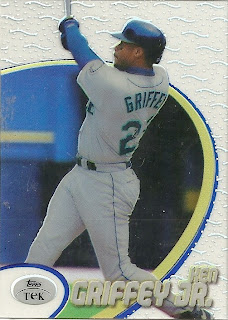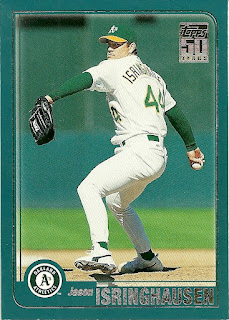#7- This was a hard set for me to rank on my countdown and I am actually going to spend a little bit of time talking about the both the 2001 Topps base set and the Traded set together on this post. The base set of the 2001 Topps set is 790 cards. Last week, I posted the 1983 Topps set as the 15th best set of the past 50 years. At the end of the post I stated that the set was the best Topps base set of the past 30 years. Meaning if you line up the 792 cards in the 1983 Topps set, it will beat any other Topps base set over that 30 year period. The Topps and Topps Traded & Rookie sets from 2001 aren't ranked 6 spots higher because of the base set. Rather, they are ranked higher because of everything else that you get in the set beyond the base set. The base set is still pretty nice.
2001 Topps Jason Isringhausen
The same card design ran throughout the first, second, and traded sets of the 2001 Topps set. The first two series of the set were a total of 790 and were all stamped with the 50th Anniversary stamp in the top left hand corner of the card. The lone notable rookie card of the base set belonged to Ichiro Suzuki. Since 2001 was Ichiro's first season in the Majors, Topps printed his full name on the card instead of the typical first name only Ichiro.
2001 Topps Ichiro Suzuki
Topps also issued a Traded & Rookies set that featured a stronger set of rookie cards than the base set. First, Topps issued a second Ichiro rookie in the Traded set along with rookie cards for Jose Reyes, Justin Morneau, and Cardinals infielder Albert Pujols.
2001 Topps Traded & Rookies Albert Pujols

In general, the rookie cards of Albert Pujols are the biggest drivers of the 2001 baseball card sets for Topps, Upper Deck, Fleer, and Donruss. Pujols had one of the greatest rookie seasons of all-time and his initial batch of cards often ranged from $50 or $60 for a simple base card from the Topps or Upper Deck card to near four digits for a copy of his autographed Topps Finest card. Topps missed Pujols in the first two series of their base set, but managed to squeeze the future Hall of Famer into the Traded set. In my opinion, this card greatly improved this set. The vast majority of 2001 releases without a Pujols rookie are generally junk sets and can easily be found for $20 or less on the secondary market. Sets with a Pujols rookie are often highly sought after, even after his career has started on a downward angle. However, the Pujols card was not the only card to drive the 2001 Topps base sets and Traded & Rookie sets to a high perch on my countdown.
2001 Topps Golden Anniversary Golden Greats Hank Aaron
As previosuly mentioned, the 2001 Topps set was the 50th Anniversary of Topps baseball cards. The company went all out on every aspect of the set and really put together a fantastic product when the set is measured as a whole. While it seems that Topps usually has a popular insert set each year, the 2001 set thrived on offering several excellent chase sets for collectors. The vast majority of the inserts played on the tradition and history of Topps and featured both modern players and cards of the all-time greats. For example, one of my favorite inserts from the set were the Golden Anniversary cards pictured above. Topps used a wide variety of players with this insert set and broke the insert set down into several small subsets. Topps also purchased cards from all 49 previous Topps sets and inserted them randomly into packs of cards along with autographs and game used cards.
2001 Topps Combos Johnny Bench and Ivan Rodriguez
Some of my other favorite inserts from the 2001 Topps set also include the Rookie Reprints, which ran throughout the first two series and Traded set, and the Topps Combos cards. The Combos set, which is pictured above, borrowed a more modern tradition from the Topps Gallery issues of inserting art cards into the set as an insert. The Topps Gallery cards were the Heritage insert set and featured mainly modern players drawn onto a classic Topps card design. The concept transferred over to the 2001 Topps set and many collectors credit with the creation of sets like Gypsy Queen and Allen & Ginter.
2001 Topps King of Kings Bob Gibson Jersey
The tip of the insert highlights in the 2001 Topps sets were the relic sets and autographs. The autographs were clearly the biggest highlight, but the relic cards were great too and well done for a relic set. While the pieces of jersey are fairly modest and ordinary, Topps did a great job of limiting the selection of players and the quantity of cards. The relic cards were insert at a rate of close to 500:1 and were only available in hobby packs. The relic set also only featured eight cards, all of Hall of Famers, with four cards in each series of Topps cards.
2001 Topps Golden Anniversary Great Johnny Bench Autograph
The odds for the autographs in the Topps set were steep and many of the cards have dried up and are no longer available on the secondary market. The few top of the line autographs that do leak out to the secondary market sell at premium prices. Some of the best autographs in the set include Willie Mays, Sandy Koufax, Chipper Jones, Stan Musial, Nolan Ryan, and Mike Schmidt. The autographs were fabulously designed and the signatures are all clean and well signed. Fortunately, if you must add one of these cards to your collection, Topps also inserted several younger players whose autographs have remained at low prices.






0E9s37IeyFBQ5Jhiq9k!~~60_57.jpg)

PhyDjKBQt36i38rQ~~60_57.jpg)





R!~~60_3.jpg)









!BQ3J0fpHQQ~~60_3.jpg)

QE9s3HE2-lBQ+f0ig30!~~60_57.jpg)


EE9s2ufh,sBQ6JVWBkIQ~~60_3.jpg)
cE9s4PtI(cBQQptgVwL!~~60_57.jpg)



BQV5gcTtI!~~60_57.jpg)











76bQfW!~~60_3.JPG)

wO3BQ9Pg!0dfQ~~60_57.jpg)
BQm04UN+0Q~~60_3.jpg)


-qe5w~~60_3.jpg)



